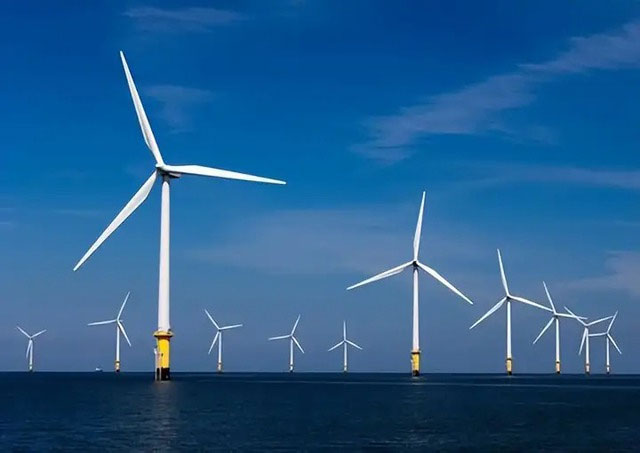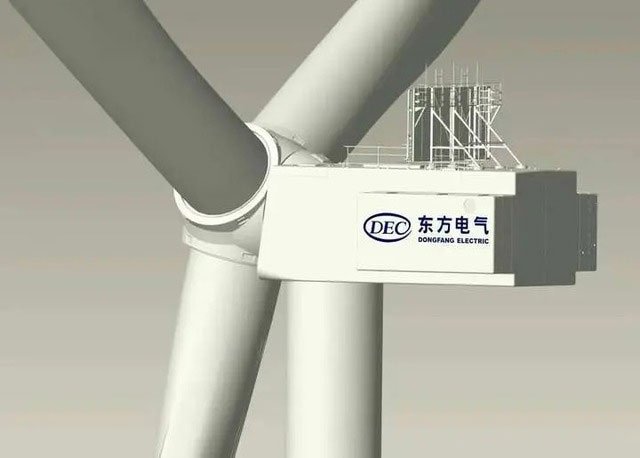What material is the world's largest wind turbine blade made of that is 9 times stronger than steel?
Today, giant wind turbines can be seen everywhere in the world. The rotation of its slender blades drives a generator that produces a steady stream of electricity. But if you look closely, you will see that the slender leaves are actually very large.
In the past, the length of wind turbine blades in Lianyungang, produced by China's Zhongfu Lianzhong, reached 123 meters, considered the largest turbine blades in the world . The mass of a single blade exceeds 50 tons, the blade root diameter exceeds 5 meters, and the surface area exceeds 1,000 square meters, suitable for offshore wind turbines. A single unit can generate power in excess of 50 million kilowatt hours.
However, wind turbine blades produced by Shuangrui Wind Power Company of China Shipbuilding Industry Group 725 in Yancheng, Jiangsu, set a new record. The rotor diameter of the SR260 blades has reached 260 meters, and the length of each blade is more than 125 meters. The wind sweeper blades have an area exceeding 53,000 square meters, equivalent to the area of 7.4 standard football fields. It can adapt to 18WM wind turbines and the annual power output can reach 74 million kilowatt hours.

But at present , the largest and longest wind turbine blade in the world has now been successfully manufactured by China Sany Heavy Energy Company using petrochemical carbon fiber (CFRP). The length of an individual propeller reaches 131 meters. This rotor uses a fully extruded carbon main beam and is equipped with an advanced trailing edge sub-beam with exceptional mechanical properties.

This 131-meter-long wind turbine blade is equivalent to the height of a 45-story building and is large enough to accommodate 340 adults standing side by side. It is currently the largest and longest wind turbine blade in the world.
With such a huge size, the material requirements are of course extremely high. The performance of traditional glass fiber (GFRP) materials reaches its limit when the wind turbine blade length exceeds 120 meters and it is difficult to meet the requirements of lightness, high strength, high stiffness as well as other requirements. of large-scale wind turbine blades. However, the use of carbon fiber materials has successfully overcome this bottleneck thanks to its excellent mechanical properties and corrosion resistance.

Fiberglass (GFRP) : GFRP is also a popular material, cheaper than CFRP but has lower strength and stiffness. GFRP is often used in combination with CFRP or for smaller wind turbine blades.
Carbon fiber is a new type of fiber material with a carbon content of over 90%. It is known as the "king of new materials" because of its super light, super durable and anti-corrosion properties. Its specific gravity is 40% lighter than steel, but its strength is 7 to 9 times that of steel, which gives it a unique advantage in the production of giant wind turbine blades. Especially when the amount of carbon fiber drawn reaches more than 48K, its performance is significantly improved.

Carbon fiber (CFRP): This is the most common material for large wind turbine blades. Carbon fiber is 9 times stronger than steel by weight, 40% lighter than steel and can withstand harsh weather conditions. Thanks to these advantages, CFRP helps wind turbine blades operate durably and effectively for a long time.
Its rotor diameter can reach 270 meters and its swept area is equivalent to 8 standard football fields and 136 basketball courts. This means that in the same amount of time, this rotor can capture more wind energy and convert it into more energy.
Carbon fiber structures, also known as CFRP (Carbon Fiber Reinforced Polymer), are composite materials made up of carbon fibers embedded in a polymer resin. Thanks to its superior properties such as high strength, light weight, high hardness and good heat resistance, CFRP has many applications in many different fields, including:
1. Aerospace
CFRP is widely used in the manufacture of aircraft, spacecraft, satellites and other parts in the aerospace industry. Thanks to its high durability and light weight, CFRP helps reduce the overall weight of the vehicle, helping to save fuel and increase performance. For example, the wings of the Boeing 787 Dreamliner are made from 50% CFRP, reducing weight by 20% compared to aircraft using traditional materials.
2. Cars
CFRP is used in the manufacture of vehicle frames, bodies, suspension systems and other automobile parts. Thanks to its high durability and light weight, CFRP helps increase safety, improve operating performance and fuel economy for cars. For example, the Lamborghini Aventador supercar uses a monocoque frame made of CFRP, which reduces weight by 35% compared to a steel frame.
3. Wind energy
CFRP is widely used in the production of wind turbine blades. Thanks to its high strength, light weight and high stiffness, CFRP helps wind turbine blades operate durably and effectively for a long time.
4. Sports
CFRP is used in the manufacture of sports equipment such as tennis rackets, golf clubs, bicycles and racing frames. Thanks to its high strength, light weight and high stiffness, CFRP makes sports equipment lighter, stiffer and more efficient. For example, the Babolat Pure Drive tennis racket uses a CFRP racket frame, which increases power and accuracy.
5. Construction
CFRP is used in reinforcing concrete structures, bridges, buildings and other construction projects. Thanks to its high strength, light weight and good corrosion resistance, CFRP helps increase the durability and longevity of the structure. For example, the Chaotianmen Bridge in China uses CFRP reinforced steel beams, which increases the bridge's load capacity and reduces maintenance costs.
6. Health
CFRP is used in the fabrication of medical implants such as artificial bones, artificial joints and dental devices. Thanks to its high biocompatibility, high durability and light weight, CFRP helps improve the quality of life for patients. For example, CFRP artificial tibias are lighter in weight and more durable than metal artificial tibias, helping patients recover faster.
- The world's largest wind turbine goes into operation in the UK
- Wind turbine balloons
- Device 'strange' exploits the power
- Wind turbine without propeller
- Wind energy is 100 times more than human needs
- Ultra-small wind turbine for smartphones
- Successfully built turbine-free turbine
- Design a wind turbine that flies automatically like a kite
- New technique helps recycle wood into stronger material than steel
- The largest wind turbine field in Africa
- Elastic cord made of material more durable than steel 200 times
- MIT team creates materials that are lighter than plastic and stronger than steel
 'Fine laughs' - Scary and painful torture in ancient times
'Fine laughs' - Scary and painful torture in ancient times The sequence of numbers 142857 of the Egyptian pyramids is known as the strangest number in the world - Why?
The sequence of numbers 142857 of the Egyptian pyramids is known as the strangest number in the world - Why? History of the iron
History of the iron What is alum?
What is alum?